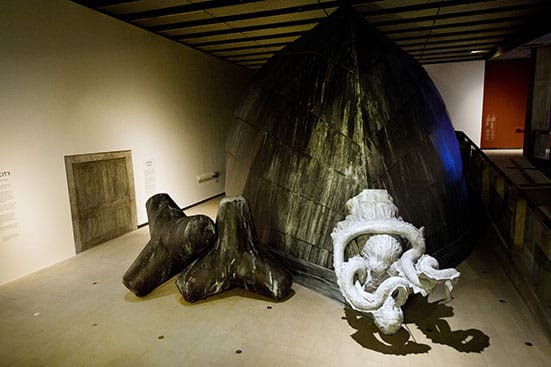Hayward Gallery, Southbank Centre, Belvedere Road, London SE1 8XX
www.southbankcentre.co.uk/venues/hayward-gallery
www.mirrorcity.southbankcentre.co.uk
Three artists from MIRRORCITY
Lindsay Seers Nowhere Less Now 4 (iamnowhere) 2014
An upside-down ship with a flaring sea thingy for a figurehead, flanked by two tetrapods, designed to protect coastlines from tsunamis.
Once inside we are faced with two flickering screens, a spherical orb, and a concave dish diagonally above it.
We see a woman, Ina Dokmo, dancing on a clifftop in Heligoland. She is reminiscing about watching a 1926 silent film of another woman, dancing on that very same clifftop.
She saw the film, The Holy Mountain, with her English father and it inspired her to become a dancer. Years later she discovered that the dancer was in fact Leni Riefenstahl, who would later become the notorious Nazi filmmaker ... The shock of this discovery triggered a mental breakdown and she is now schizophrenic. Her father has the same condition. He was sailor in Zanzibar during the 1960s and is plagued with ‘psychotic guilt’ about the Zanzibar Massacre of 1964, which he quite incorrectly thinks he’s responsible for.
Ina, suffering with a corresponding guilt, imagines she’s somehow to blame for the Holocaust.
We are introduced to Sayyida Salme, Princess of Zanzibar, daughter of the Sultan of Oman, who in 1866 has to leave Zanzibar immediately because she has become pregnant by her German lover. Ina’s great-great grandfather will carry them away to safety in a Royal Navy ship and the couple will later settle in Germany.
We are told of the 1890 Heligoland-Zanzibar Treaty, an agreement for Germany to give Zanzibar to Great Britain in exchange for the tiny island of Heligoland.
Its ramifications will prove significant for both the Princess and Leni Riefenstahl, whose lives converge in a succession of coincidences and parallels that entwine all the characters in the story.
There are more facets to the narrative, some of which is factual, painstakingly researched by Seers, but she is an unreliable storyteller. She joyfully chops up the timelines as the action swirls backwards and forward through the centuries in a collage of antique photographs, film and animation that tumbles relentlessly from the screens. The details come to us like attempts to recall a half forgotten dream. She digresses, backtracks, and wilfully misleads, and it’s difficult to untangle fact from fantasy.
We are left exhilarated, and quite, quite disorientated.
Hannah Sawtell #DECELERATOR (2014)
Within a series of freestanding steel frameworks, photo transparencies are positioned at various angles and heights.
Initial glances register glittering bitcoins, the interior of a new car, and a Chinese Stock Exchange graph.
They are library shots, slickly executed and impersonal, the type that are routinely harvested from the net, with or without the owners’ permission.
Any one photo might be copied and pasted repeatedly, simultaneously existing on any number of websites. Whatever the level of coherence and trustworthiness of each accompanying text, the photo will silently do its job.
Sawtell has downloaded these images too.
She describes this piece as ‘a physical glimpse of the digital image as form’, and speaks of salvaging and rerouting these transitory elements to ‘turn them into slow repetitive propositions’.
There is more is going on here. The Chinese Stock Exchange graph is at uneasy variance with a photo of Chinese-built housing for workers in West Africa.
Another photo is revealed to be of tantulum, a rare metal used in electronic equipment and medical implants. Found in Central Africa, the UN reports that smuggling it out of the region is playing a part in fuelling the war in the Democratic Republic of the Congo.
Nearby, a close-up of the Ebola virus lurks ominously.
Studies of a 3D printed human heart and of graphene, the so-called miracle material, strike a more optimistic note. There are also shots of a proposed self-sustaining habitat on Mars and a macro shot of a water droplet. The implications of these are not so clear-cut.
Suspended amidst the frameworks, neat sprayed-white speakers fizz.
Emma MacNally Choral Fields 1-6 (2014)
In a vaguely hexagonal enclosure we are surrounded by large sheets of white paper with something resembling nautical or aviation charts on them. There are complex grids, circles, parallel lines and converging lines, patiently built up, all monochromatic. One could be a large physical map, of a flat area, with roads and boundaries marked – except the open-ended rhombus in the middle is puzzling. A fence, perhaps. But there are also long enclosed strips and these appear to be three-dimensional. In the bottom left-hand corner is a dark grey smudge. Another is all over grey with darker cloud-like smudges. A concentric pattern shows through from below, in some areas more than others. Another sheet appears to show light shining through fog.
MacNally listens to music while she works, generating rhythms and space and sound. She endeavours to create as much visual information as possible, using graphite pencil for the patterns and carbon to create deep blacks, and rubbing away at the surface with sandpaper to vary the tone. The finished pieces are truly absorbing. They are dynamic from a distance but the temptation to get closer and analyse the details is constant.
There are many more artists featured in this exhibition and a number of the pieces are time-based, so get there early.
A programme of events connected to the show runs for the duration of the exhibition. These are listed on the dedicated MIRRORCITY website along with an ocean of other items related to the project.
Phil Harris

Lindsay Seers Nowhere Less Now 4 (iamnowhere) 2014

Hannah Sawtell #DECELERATOR (2014)

Emma McNally Choral Field 1-6 2014 © the artist, 2014